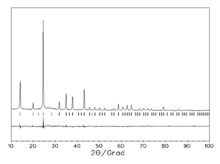Rietveld method
The Rietveld method is a computational method originally developed in 1966 by the Dutch physicist Hugo Rietveld (1932–2016) for the crystal structure analysis of polycrystalline samples analogous to the Debye-Scherrer method using neutron radiation . It has also been used for X-ray examinations since 1977 . Since the mid-1970s, the Rietveld method has also been used for quantitative phase analysis, i.e. for the quantitative determination of the crystalline components of a powdery sample.
principle

The X-ray diffraction diagram (also XRD diagram or diffractogram ) of a polycrystalline substance is viewed as a mathematical function of the diffraction angle, which is also dependent on structural parameters. These are given by the spatial arrangement of the atoms, i.e. the crystal structure . Starting from an initial model of the atomic arrangement, these structural and additional instrumental parameters are continuously refined. The mathematical method of least squares is usually used as the method . These refinement steps are repeated until, ideally, there are no longer any differences between the calculated and the found XRD diagram. In practice, however, this case can hardly be achieved.
literature
- HM Rietveld: The Rietveld Method: A Retrospection. In: Z. Kristallogr. 225, 2010, pp. 545–547, doi : 10.1524 / zkri.2010.1356 ( PDF )
- RA Young: The Rietveld Method . Oxford University Press, ISBN 0-19-855577-6 .
- Rudolf Allmann : X-ray powder diffractometry . Verlag Sven von Loga, ISBN 3-87361-029-9 .
- C. Giacovazzo: Fundamentals of Crystallography . Oxford University Press, ISBN 0-19-855578-4 .
Individual evidence
- ↑ International Union of Crystallography: Hugo Rietveld (1932-2016)